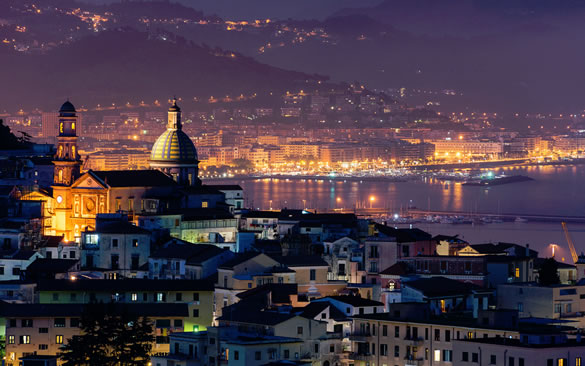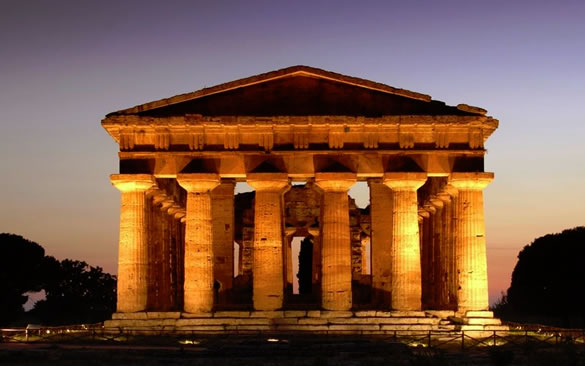
Salerno is the main town close to the Amalfi coast and it is mostly known for its Schola Medica Salernitana (the first University of Medicine in the world, dating back to the IX century A.D).
In recent history the city hosted the King of Italy, who moved from Rome in 1943 after Italy negotiated a peace with the Allies in World War II. Some of the Allied landings during Operation Avalanche (the second landing in Italy) occurred near Salerno.
Today Salerno is an important cultural centre in Campania and Italy and has had a long and eventful history. The city has a rich and varied culture, and it is divided into three distinct regions: the medieval sector with a modern state-of-the arts area, the planned 19th century district and the more densely-populated post-war area, with its several apartment blocks.
Paestum was probably founded around 650 BC by a large group of Dorians who had been expelled from the city of Sybaris, a luxurious resort across the mainland on the Ionian Sea. The Dorians named their new colony Poseidonia, after the most important of their gods; it flourished and quickly became the greatest city on the gulf of Salerno. In 390 BC it fell to a tribe of local barbarians called the Lucanians. In 273 BC, the Romans arrived. They changed the citys name, but we know as little about Roman Paestum as we do about its Greek predecessor. In 79 AD, the eruption of Vesuvius partially destroyed it. Perhaps it was volcanic ash that helped to silt up the mouth of the river on which the city stood; this led the surrounding countryside to become swampy and mosquito-ridden. Christianity arrived slowly, leaving some traces of its presence in the Ceres Temple, which was turned into a burial place for the Christians themselves.
Incredibly, although Paestum's Temple of Hera (also called "of Poseidon") was among the most famous cult-worship sites in antiquity, and although it is the oldest, best preserved and most beautiful Doric temple in existence today, these majestic ruins were unknown all through the Middle Ages and the Renaissance. They were discovered just in 1740 and not accurately described until 1779.
Mozzarella is a generic term for several kinds of Italian cheeses that are made using spinning and then cutting (hence the name, as the Italian verb mozzare means "to cut"):
Types:
Mozzarella di bufala campana (PDO 1996) is a particular type of mozzarella, made from the milk of water buffalo raised in designated areas of Lazio and Campania; some consider it the best for flavour or quality.
Fior di latte (written also as fiordilatte) is used to distinguish the mozzarella made from cow's milk from that made from buffalo's milk; when twisted to form a plait it is called treccia.
Book with our local GTA guide your excursion!
We offer discounts on rates depending on the period, the number of passengers and the number of services requested.
Each tour can be combined as desired, always contacting us via the form.
Duration:
8 Hours about
Suitable for families:
Yes
Suitable for the disabled:
No
Meeting place:
To be defined
Skip the line:
No
Language:
Italiano, English, Deutsch
Type Guide:
Local guide enabled in archaeological tours
More info:
We recommend comfortable shoes; within the site smoking is prohibited; large backpacks cannot be introduced. A cloakroom service is available at the entrance.

